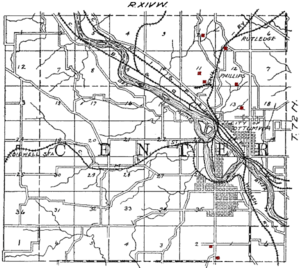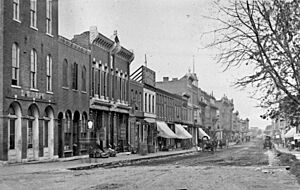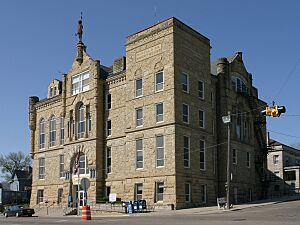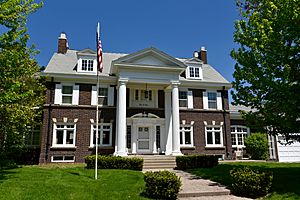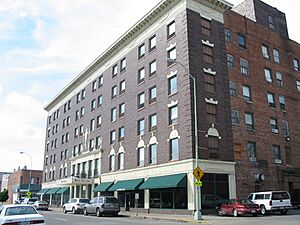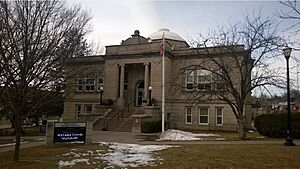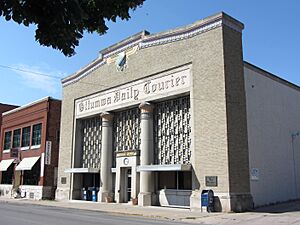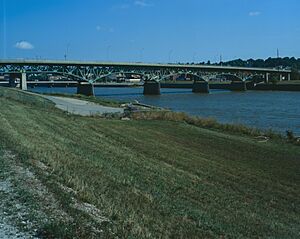Ottumwa, Iowa facts for kids
Quick facts for kids
Ottumwa, Iowa
|
|
|---|---|
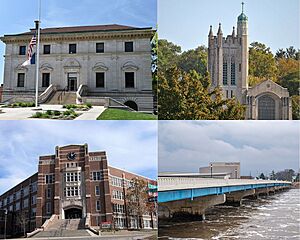
Clockwise from top left: Ottumwa City Hall (Federal Building), St. Mary of the Visitation Catholic Church, Market Street Bridge and Bridge View Center, and Ottumwa High School
|
|
| Nickname(s):
City of Bridges
Video Game Capital of the World |
|
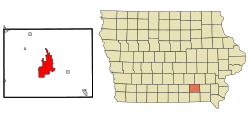
Location of Ottumwa in the State of Iowa
|
|
| Country | |
| State | |
| County | Wapello |
| Government | |
| • Type | Mayor/Council |
| Area | |
| • Total | 16.73 sq mi (43.32 km2) |
| • Land | 16.06 sq mi (41.60 km2) |
| • Water | 0.67 sq mi (1.73 km2) |
| Elevation | 650 ft (200 m) |
| Population
(2020)
|
|
| • Total | 25,529 |
| • Rank | 18th in Iowa |
| • Density | 1,589.50/sq mi (613.71/km2) |
| Time zone | UTC−6 (Central) |
| • Summer (DST) | UTC−5 (CDT) |
| ZIP Code |
52501
|
| Area code(s) | 641 |
| FIPS code | 19-60465 |
| GNIS feature ID | 2396110 |
Ottumwa is a city in Iowa, United States. It is the main city of Wapello County. In 2020, about 25,529 people lived there. The city is in the southeastern part of Iowa. The Des Moines River splits the city into two halves.
Contents
History of Ottumwa
The name "Ottumwa" comes from the Meskwaki Native American language. It means "tumbling waters," which describes the rapids on the Des Moines River.
In May 1843, some people decided to start a new town. They claimed land where three Native American groups lived. The first official building was put up in May 1843. The town was first called Louis Ville. In 1844, it became the main city for the county, known as the county seat.
A big flood in 1851 caused a lot of damage to the town.
Coal Mining and Growth
Coal mining became very important to Ottumwa. In 1857, people started mining coal nearby. By 1872, one company, Brown and Godfrey, had 300 workers and produced a lot of coal. More mines opened over the years. By 1889, there were 15 coal mines in Ottumwa. Coal was so important that from 1890 to 1892, a special building called the Coal Palace was built to show off the coal industry.
A large meat-packing company, John Morrell & Company, also helped Ottumwa grow from 1877 to 1973.
When the Burlington and Missouri River Railroad arrived in 1859, it helped the city's businesses and factories grow. At first, people crossed the river by ferry. Later, a bridge was built. Most of the early growth was on the north side of the Des Moines River. The south side of the river, called South Ottumwa, became part of the city in the 1880s.
Presidential Visits to Ottumwa
Several U.S. presidents have visited Ottumwa:
- Benjamin Harrison came in 1890. He saw the Coal Palace and spoke to a large crowd.
- Theodore Roosevelt made a quick stop in 1903 during a train trip.
- Harry Truman visited in 1950 to support his "Fair Deal" plan.
- Richard Nixon arrived by Air Force One in 1971. He dedicated the Rathbun Lake dam. Nixon had been stationed at the Ottumwa airport during World War II.
- Barack Obama spoke at Indian Hills Community College in 2010.
Geography of Ottumwa
Ottumwa covers about 16.53 square miles. Most of this area is land, and a small part is water.
The area around Ottumwa has a lot of coal and clay. These natural resources were important for the city's industries.
Ottumwa is the center of the Ottumwa Micropolitan Statistical Area. This area includes all of Wapello County.
Climate in Ottumwa
Ottumwa has a climate with hot summers. It is known as a "hot-summer humid continental climate." This means it has warm, humid summers and cold winters.
People in Ottumwa
| Historical population | |||
|---|---|---|---|
| Census | Pop. | %± | |
| 1860 | 1,632 | — | |
| 1870 | 5,214 | 219.5% | |
| 1880 | 9,004 | 72.7% | |
| 1890 | 14,001 | 55.5% | |
| 1900 | 18,197 | 30.0% | |
| 1910 | 22,012 | 21.0% | |
| 1920 | 23,003 | 4.5% | |
| 1930 | 28,075 | 22.0% | |
| 1940 | 31,570 | 12.4% | |
| 1950 | 33,631 | 6.5% | |
| 1960 | 33,871 | 0.7% | |
| 1970 | 29,610 | −12.6% | |
| 1980 | 27,381 | −7.5% | |
| 1990 | 24,488 | −10.6% | |
| 2000 | 24,998 | 2.1% | |
| 2010 | 25,023 | 0.1% | |
| 2020 | 25,529 | 2.0% | |
| US Decennial Census | |||
Population Facts
In 2020, Ottumwa had 25,529 people. There were about 10,098 households. The city had about 1,589 people per square mile.
Most people in Ottumwa (74.3%) were White. About 5.4% were Black or African American, and 2.3% were Asian. People of Hispanic or Latino background made up 15.7% of the population.
The average age in Ottumwa was 36.7 years old. About 27.9% of the people were under 20 years old.
Economy and Jobs
Main Employers
Here are some of the biggest employers in Ottumwa as of 2023:
| # | Employer | # of Employees |
|---|---|---|
| 1 | JBS Live Pork, LLC | 2,550 |
| 2 | Ottumwa Community School District | 800 |
| 3 | Ottumwa Regional Health Center | 692 |
| 4 | John Deere Ottumwa Works | 550 |
| 5 | Winger Companies | 449 |
| 6 | Indian Hills Community College | 369 |
| 7 | Hy-Vee | 350 |
| 8 | Walmart Supercenter | 301 |
| 9 | City of Ottumwa | 224 |
| 10 | Keurig Dr Pepper | 200 |
The Quincy Place Mall is a shopping center in Ottumwa.
Arts and Culture
Historic Places
Ottumwa has several historic areas and buildings:
- Historic Railroad District
- Fifth Street Bluff Historic District
- Ottumwa Cemetery
- Court Hill Historic District
- Vogel Place Historic District
- North Fellows Historic District
Some important historic buildings include:
- First National Bank Building (built 1915)
- Hotel Ottumwa
- B'nai Jacob Synagogue
- Trinity Episcopal Church
- Ottumwa Public Library
- St. Mary of the Visitation Catholic Church
- Ottumwa City Hall
- Wapello County Courthouse
Video Games in Ottumwa
Twin Galaxies, a website for video game records, is in Ottumwa. Because of this, Ottumwa's mayor called the city the "Video Game Capital of the World" in 1982. Even U.S. Senator Charles Grassley recognized this. The city hosted the first North American Video Olympics in 1982. There were also plans for an International Video Game Hall of Fame in 2009.
Education in Ottumwa
Public Schools
The Ottumwa Community School District serves students in Ottumwa and the surrounding areas.
Students attend Ottumwa High School and Evans Junior High. There are also many elementary schools, like Douma, Liberty, James, Horace Mann, Wilson, Eisenhower, and Fahrney Elementary.
Colleges
Ottumwa is home to Indian Hills Community College. This is a two-year college. From 1928 to 1980, there was also a women's college called Ottumwa Heights College. It joined with Indian Hills in 1979. Buena Vista University also has a campus in Ottumwa.
Media and News
Ottumwa is part of a media market with Kirksville, Missouri. This means they share some TV and radio stations.
TV stations include Fox/NBC/The CW+ affiliate KYOU-TV (channel 15). There is also KTVO (channel 3), which is an ABC/CBS affiliate. KTVO has an office in Ottumwa.
The main daily newspaper is the Ottumwa Courier. "Ottumwa Radio" provides several local radio stations.
Transportation and Infrastructure
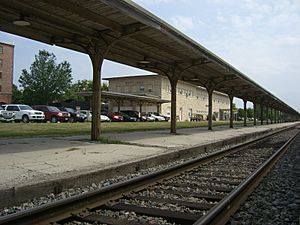
Getting Around Ottumwa
The Ottumwa Regional Airport is used for general aviation. It is owned by the city.
Amtrak, the national passenger train system, has a station in Ottumwa. The California Zephyr train stops here daily. It travels between Chicago, Illinois, and Emeryville, California.
The Ottumwa Transit Authority runs bus services in the city. There are five bus routes during the week and a shopping shuttle. They also have special services for people who need extra help.
Regional bus services are also available through the 10–15 Regional Transit Agency.
U.S. Route 34 and Iowa Highway 149 go through Ottumwa. The Jefferson Street Viaduct is a historic bridge over the Des Moines River.
Railroads in Ottumwa
The BNSF Railway has train tracks that go through Ottumwa. This is a very busy route for trains carrying coal and other goods. The tracks go under U.S. Highway 34 and through the city's business area.
The Iowa, Chicago and Eastern Railroad also has tracks in Ottumwa. This line goes from Davenport, Iowa, to Kansas City, Missouri.
The Norfolk Southern Railway also uses the BNSF tracks through Ottumwa.
Famous People from Ottumwa
- Tom Arnold – actor
- Chris Ash - football coach
- Steve Bales – Apollo 11 flight controller
- Walter Day – video game statistician
- Edna Ferber – novelist
- Donald Keyhoe – Marine Corps major and UFO researcher
- Dan Knight – jazz pianist and composer
- Herschel Loveless – former Governor of Iowa and Mayor of Ottumwa
- Mariannette Miller-Meeks – Iowa Congresswoman
- Carol Morris – Miss Universe 1956
- Adam Young – musician
Images for kids
-
Clockwise from top left: Ottumwa City Hall (Federal Building), St. Mary of the Visitation Catholic Church, Market Street Bridge and Bridge View Center, and Ottumwa High School
See also
 In Spanish: Ottumwa (Iowa) para niños
In Spanish: Ottumwa (Iowa) para niños


